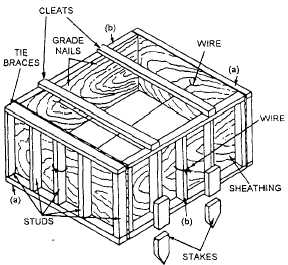placing. By knowing these two factors and the type of form material to be used, you can calculate a tentative design.
FORM CONSTRUCTION
Strictly speaking, it is only those parts of the form work that directly mold the concrete that are correctly referred to as the "forms." The rest of the formwork consists of various bracing and tying members. In the following discussion on forms, illustrations are provided to help you understand the names of all the formwork members. You should study these illustrations carefully so that you will understand the material in the next section.
Foundation Forms
The portion of a structure that extends above the ground level is called the superstructure. The portion below the ground level is called the substructure. The parts of the substructure that distribute building loads to the ground are called foundations. Footings are installed at the base of foundations to spread the loads over a larger ground area. This prevents the structure from sinking into the ground. It's important to remember that the footings of any foundation system should always be placed below the frost line. Forms for large footings, such as bearing wall footings, column footings, and pier footings, are called foundation forms. Footings, or foundations, are relatively low in height since their primary function is to distribute building loads. Because the concrete in a footing is shallow, pressure on the form is relatively low. Therefore, a form design based on high strength and rigidity considerations is generally not necessary.
SIMPLE FOUNDATION. - Whenever possible, excavate the earth and use it as a mold for concrete footings. You should thoroughly moisten the earth before placing the concrete. If this is not possible, you must construct a form. Because most footings are rectangular or square, you can build and erect the four sides of the form in panels.
Make the first pair of opposing panels (figure 7-1 (a)) to exact footing width. Then, nail vertical cleats to the exterior sides of the sheathing. Use at least

Figure 7-1.-Typical foundation form for a large footing.
1-by-2-inch lumber for the cleats, and space them 2 1/2 inches from each end of the exterior sides of the panels (a), and on 2-foot centers between the ends. Next, nail two cleats to the ends of the interior sides of the second pair of panels (figure 7-1 (b)). The space between these panels should equal the footing length plus twice the sheathing thickness. Then, nail cleats on the exterior sides of the panels (b) spaced on 2-foot centers.
Erect the panels into either a rectangle or square, and hold them in place with form nails. Make sure that all reinforcing bars are in place. Now, drill small holes on each side of the center cleat on each panel. These holes should be less than 1/2 inch in diameter to prevent paste leakage. Pass No. 8 or No. 9 black annealed iron wire through these holes and wrap it around the center cleats of the opposing panels to hold them together (see figure 7-1). Mark the top of the footing on the interior side of the panels with grade nails.
For forms 4 feet square or larger, drive stakes against the sheathing, as shown in figure 7-1. Both the stakes and the 1 by 6 tie braces nailed across the top of the form keep it from spreading apart. If a footing is less than l-foot deep and 2-feet square, you can construct the form from 1-inch sheathing without cleats. Simply make the side panels higher than the footing depth, and mark the top of the footing on the interior sides of the panels with grade nails. Cut and
Continue Reading